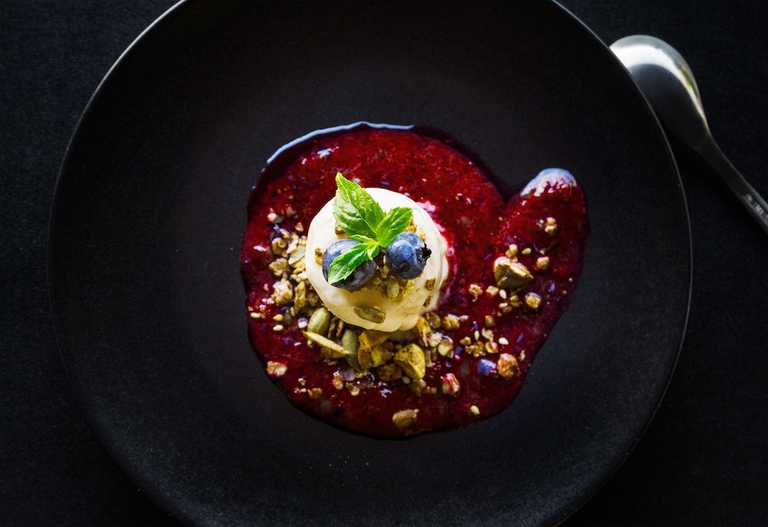
Factory farming conditions and antibiotic-resistant pathogens emerging as a result of them pose an existential threat to humans in the form of zoonotic diseases. Why it’s time to produce and consume food more thoughtfully.
In its variegated journey zigzagging between history and geography, ice cream has evolved from being a dessert for the powerful elite to a street food loved by all and eaten all year round. Way back in Mesopotamia and ancient Egypt, drinks with ice or snow were served to the rich and powerful, but it took
In its variegated journey zigzagging between history and geography, ice cream has evolved from being a dessert for the powerful elite to a street food loved by all and eaten all year round. Way back in Mesopotamia and ancient Egypt, drinks with ice or snow were served to the rich and powerful, but it took several more millennia before master confectioners in Italy created the formats and flavours that have now conquered the world. All the names and facts surrounding the history of ice cream.
What could call itself the first ice cream cup was found in Egypt in a tomb from the Second Dynasty (2700 BC). This was a kind of mould, consisting of two silver cups, one of which contained snow (or crushed ice) and the other cooked fruit. “Icehouses”, where snow was stored and ice deliberately formed, were undoubtedly an extremely ancient invention.
In Ancient Rome special wells were used to store ice and snow which slaves brought down from to mountains to luxurious villas. Among the ruins of Pompeii there are traces which lead us to believe that some shops specialised in selling crushed ice (from Vesuvius) sweetened with honey.
Gathering ice to preserve food was a practice in Japan (where Emperor Nintoku proclaimed an Ice Day) and in China, over a thousand years ago. In the Shih Ching, an ancient collection of odes, mention is made of an ice-gathering festival. During the Tang Dynasty an elegant drink was recorded, consisting of milk (goat, cow or buffalo) cooked with flour and camphor and then placed in iron containers and buried in snow or ice. The Arabs prepared cold drinks with cherries, quinces and pomegranate. ‘Sorbet’ and ‘sorbetto’ come from the Turkish word sherbet meaning ‘cool drink’, from the Arab sharab, to drink.
The first ‘ice cream’ on the American continent was the ‘Paila’, a tradition in Pre-Columbian Ecuador. The Caranquis (or Caras), before being conquered by the Incas, sent expeditions to bring blocks of ice and snow down from the top of the volcano Imbabura, wrapped in thick layers of straw and frailejòn leaves, for thermal insulation. The ice cream was then made by filling a large cauldron (called a “paila”) with ice, snow and fruit juice (and sometimes milk also), and mixing vigorously until the juices and ice froze together. Using this ancestral technique, gradually perfected over centuries, helados de paila are still prepared traditionally today in some places in Ecuador, especially in the modern town of Imbabura.
Legend has it that the Medici family organised a competition for the most original culinary recipes which was won by a certain Ruggeri (a chicken seller), who had submitted a composition of water, sugar and fruit, probably similar to a granita, an “ice with sugared and perfumed water”. There is some dispute about whether it was Catherine de’ Medici, when leaving for her marriage to the Duke of Orleans and future King Henry II, who brought Ruggeri and his ice cream arts across the Alps.
Another story somewhere between legend and reality regards the architect Bernardo Buontalenti inventing an iced dessert for Charles V of Spain at a famous inaugural feast for the Belvedere Fort of Cosimo I de’ Medici in 1559. Thanks to this event, some people consider Buontalenti the true inventor of ice cream: his recipe is recorded as a cold cream made of milk, honey, egg yolk, a sprinkle of wine, aromatised with bergamot, lemon and orange. This is certainly the basic recipe for the “Florentine Cream” or “Buontalento Ice Cream” which the best ice cream makers in Florence still serve. It is said that Buontalenti even had a machine built, consisting of revolving slats driven by a handle to beat the mixture and a cylinder in the center filled with ice.
The French author Nicolas Lemery cites the first recipe in French for aromatised ice, in his book Recueil de Curiosités les plus rares et admirables, a collection of naturalistic curiosities.
“Cantinette e cantimplore stieno in pronto a tutte l’ore, con forbite bombolette chiuse e strette tra le brine delle nevi cristalline” – “Let cellars and ice-jugs be at the ready, and decanters packed to the neck in crystalline snow”, wrote the scientist and poet Francesco Redi in his poem Arianna inferma on the subject of iced drinks, continuing that “Snow is the fifth element needed for the best drinks: he is a fool who thinks to attain true drinking pleasure without the help of snow.” The “bomboletta” was a glass container with a twisted neck, designed to be plunged in ice or snow to cool wine (the garden of the Grand Duke of Tuscany had a whole hillside dedicated to making ice).
The “cantimplora”, on the other hand, was a large glass container with a chamber in the middle which could be filled with ice or snow to chill the wine it contained, with a long neck protruding from one side, as in a watering can. Lorenzo Magalotti later described a similar item as a large golden sorbet-maker (the Medici Ambassador to Vienna, in his Canzonette anacreontiche of 1723, was describing in verse the first rudimental devices for making sorbets).
While these containers were in use in Tuscany, Sicily was developing a flourishing ice industry: large wells or natural crevices were filled with snow in the winter (from Etna, or from the Hyblaean or Madonie Mountains) and then sold in large blocks in the summer. Francesco Procopio de’ Coltelli, a Sicilian cook, emigrated to Paris and opened a café, one of the first such establishments. The Cafè Procope became a fashionable high society meeting place, and the enterprising Sicilian ingeniously multiplied his repertoire of “iced waters”, substituting the honey with sugar and adding salt to the ice in order to chill the preparations more quickly and make them last longer. His menu of “acque gelate” (granitas) came to include flavours such as “aniseed flower”, “cinnamon flower”, “frangipane”, “lemon juice gelato”, “orange juice gelato” and “strawberry sorbet”.
Details of well-organised recipes for making sorbets: written by Antonio Latini, chef du table and director of the kitchens for a Spanish viceroy in Naples, in his publication “Lo scalco alla moderna, overo l’arte di ben disporre i conviti, con le regole piu scelte di scalcheria” – “The modern banqueting director, or the art of arranging banquets, with the most important rules of banqueting etiquette”. This book meticulously transcribes the best recipes for making “sorbetti in Naples”, described as the home of the art of sorbet-making, where sorbets are not only served at aristocratic tables but also in taverns and inns.
One chapter is specifically headed “A Treatise on various kinds of sorbets or iced waters”, describing in detail how to mix snow with sugar, salt, lemon juice, strawberries, cherries and chocolate. Latini also describes a pine nut flavor and an aubergine recipe. Especially interesting is his mention of a “sorbet made of cooked milk”, indicating a big step towards modern ice cream. His recipe? Cook a pot of milk, sugar and water, garnish with sugared citron and pumpkin, and then freeze. Various gastronomic historians argue that this milk sorbet can lay claim to be “the first ice cream in history”.
In this period the mastery of Italians in preparing sorbets is recognised across Europe. The French confectioner Nicolas Audiger, in his treatise La Maison reglée, informs his readers that the only legitimate way to create iced drinks is to follow “the Italian style”. Wine, spices and fruit are frequent ingredients.
Wafers rolled into a cone shape were certainly in use by the late 1700s, served at the end of the meal or along with fruit and pastries. They are specifically mentioned by Bernard Claremont in The Professed Cook (1769) and Mary Smith in The Complete Housekeeper & Cook (1770).
The ice cream arrives in the United States, brought to New York by Giovanni Basiolo. At the time, not many different types of ice cream were known apart from sorbets and the more rare milk and chocolate or milk and cinnamon variants. In New York Basioli made a success of selling Panera, a semi-frozen coffee and milk product popular in Genoa. In 1773 the first known newspaper advertisement for ice cream appeared: “Just arrived from London, Monsieur Filippo Lenzi, confectioner, makes and sells candied fruit, brandy, pastas, jellies, dragees, every kind of sweets, with barley, with white or brown sugar, iced products and fruit.”
In Naples Doctor Filippo Baldini publishes De’ sorbetti e de’ bagni freddi saggi medico-fisici – On sorbets and frozen products, the medical and physical benefits, the first book entirely devoted to this subject. Here he classifies sorbets in subacid flavours (citron, lemon, strawberry, orange, pineapples, bitter grapes), aromatic flavours (cinnamon, chocolate, coffee, pistachio, pine nuts) and milky flavours (still closer to today’s ice cream). He also ascribes varied medical benefits to sorbets: “Frozen products undoubtedly produce countless positive effects in our bodies.”
George Washington inaugurates the celebrations for the birth of a new heir to the French throne with an important party serving iced products. These are also served in various receptions and events throughout the summer, which becomes habitual. In the summer of 1790 the substantial sum of 200 dollars stands in the accounts as spent on sorbets for official occasions.
A breakthrough in the history of ice cream: in 1843 Nancy M. Johnson creates and patents a machine with a manually operated handle to make iced products (an “artificial freezer”), whose basic principles remain valid to this day. Two years later William Young adds a motor. In 1851 Jacob Fussel, the owner of a dairy shop, at the end of the day pours leftover cream and milk into the artificial freezer, and shortly afterwards opens the first ice cream factory, in Seven Valleys.
The birth of the Sundae: cups of vanilla ice cream with various syrups, garnishes and decorations on top. Their birthplace and naming is heatedly disputed between Two Rivers in Wisconsin and Ithaca in the State of New York.
In Turin one of the earliest ice cream parlours opens: the Gelateria Pepino, still open today. One of its most important innovations was the use of dry ice to transport ice cream, but in 1939 it was also the first to patent a coated ice cream on a stick.
The birth of the ice cream cone. In 1896 Italo Marchioni, having emigrated from north-eastern Italy to New York and opened various restaurants, begins to serve and sell cone-shaped wafer cups and patents his method of making them in 1903. The patent is disputed by Antonio Valvona, who in 1902, in Great Britain, had patented an oven for baking “biscuit cups for ice creams.” In 1904, at the St. Louis World Fair, the Syrian Ernest A. Hamwi, had a stand selling Zalabia (a kind of wafer) right next-door to one of the fifty stands selling ice cream. He had the idea of curving his wafers to make them cone-shaped, and offered them to replace the ice cream stall’s plates. Twenty years later, the number of cones with ice cream inside sold in the USA topped 245 million.
The advent of ice cream vans. Harry Burt, owner of an ice cream parlor in Youngstown in Ohio – and one of the first to sell strolling ice creams on a stick, called the Good Humor bar – invests in buying 12 vans with refrigeration units, in order to sell ice cream in the whole Mahoning Valley. By the 1950s he owns 2,000 vans.
The invasion of the ice pops. In 1923, the Californian Frank Epperson patents a “frozen ice on a stick”. At first he calls these Eppsicles, but soon changes the name to Pop’s Icle (Popsicle is still one of the general names used for ice on a stick products in the USA). To start with he sells them at 5 cents each, offering 7 flavors including cherry, which is still the most popular. Two years later he sells the patents and the Popsicle brand to the Joe Lowe Company of New York.
Throughout the 1800s and the first decades of the 1900s, homemade ice cream was made with manual devices consisting of a hollow interspace around a main container, the former filled with ice and salt, the latter with the mix to be frozen, with a manual handle turned to operate some kind of stirring or mixing system so that the mix would freeze homogeneously. In 1927, Otello Cattabriga from Bologna developed a mechanical system which imitated the system used for churning butter. His system of attaching a motor to the blending system became highly successful and he soon left his shop in Via Mazzini to manufacture his “electric motor-ice-cream-makers” on an industrial scale: they were soon famous all over the world.
J.F. McCullough (known as Grandpa) and Alex McCullough invents soft ice cream, forerunner of Dairy Queen, based on the realisation that the ice cream mix tasted better before it was entirely frozen. So they developed a system of incorporating more air in the ice cream.
The first ice cream factories opened in the USA before the war, while in Italy pre-confectioned ice cream was a post-war phenomenon, with the first ice creams on a stick opening the road to a boom in the 1950s and 60s which has continued to this day. On the one hand, in recent years home-made or artisan ice cream has become increasingly sophisticated in technique and ingredients, but on the other, the 20th century is the century of mass consumption, thanks a stream of innovations and combinations, of technological developments on all sides, intersecting with changing cultural customs of all kinds. The shiny display cards on freezers in bars and cafés, advertising carry out ice pops and ice creams filled our childhoods with flavours, while the same products invaded cartoons, films and of course TV commercials and slogans… protagonists of popular consumer culture.
Consumption grows incessantly and production improves its quality and safety standards. In the 1950s, Italians ate 2.5 kilos of ice cream per person per year, today that figure has doubled (AIDI statistic), and the trend is accelerating: ice cream has what it takes to be considered a food item which is delicious, characteristic, hygienically impeccable and offering optimal nutritional properties in a vast range of varieties and tastes: fresh fruit, gluten-free production system, with haute cuisine or unusual ingredients like baobab, DOP Grana cheese, basil, tomato and even mortadella.
Siamo anche su WhatsApp. Segui il canale ufficiale LifeGate per restare aggiornata, aggiornato sulle ultime notizie e sulle nostre attività.
![]()
Quest'opera è distribuita con Licenza Creative Commons Attribuzione - Non commerciale - Non opere derivate 4.0 Internazionale.
Factory farming conditions and antibiotic-resistant pathogens emerging as a result of them pose an existential threat to humans in the form of zoonotic diseases. Why it’s time to produce and consume food more thoughtfully.
The world of cinema recognises the link between food choices and the climate crisis by offering vegan menus for awards season events, including at the most important of them all: the Oscars.
Let’s look at the reasons behind the growth of veganism in India, as a small yet vocal section of the population turns towards this diet and lifestyle in the largest milk producing country in the world.
by Jeffrey Y. Campbell, Manager of the Forest and Farm Facility at FAO In the Ecuadorian Amazon, Kichwa farmers grow dozens of products on tiny parcels of land. Their lands hum with biodiversity, yielding nutritious foods that have sustained families for generations. Wandering among fruit and nut trees and crops, these indigenous agroforesters fill their baskets
Mint has many health benefits, but in food it’s often accompanied by artificial green colourings. Instead, Galatea has created a green mint ice cream in a completely natural way.
We’re talking about Galatea, a company that produces semi-finished products for artisanal ice creams using high quality ingredients, natural colouring, excluding thickeners and hydrogenated fats, respecting the environment and supporting the less fortunate.
The mad rush to fake food, like fake meat made with genetically-modified soy, ignores the importance of the diversity of our foods and culinary cultures. It’s a recipe to accelerate the destruction of the Planet and our health.
Like with all foods, the quality of an ice cream can be discerned by reading its label. An expert explains how to do this, and tells us how their company steers clear of chemicals, using only natural ingredients to produce an excellent and “free” ice cream.
Quality ingredients, no artificial colouring and hydrogenated fats. These are the main features of a great ice cream. But what makes an ice cream parlour “good”, i.e. sustainable?














